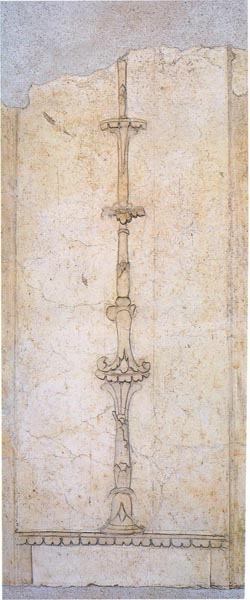The frescoed house
The southern part of the L-shaped building located to the SE of the Baths (fig. 1) includes a series of three communicating rooms, accessible from the corridor, which can be interpreted as a house belonging to a medium-high class.

Fig. 1 - In green the three rooms of the house with frescoes (from Bacco - Serra 1998; re-worked by C. Tronchetti).
The room dug out has brought to light walls decorated with good style level paintings (figs. 2-6).

Fig. 2 - L-shaped Building. Wall frescoed in
panels: to the left a narrow panel with a
stylised decoration; to the right a panel portraying a fantastic sea animal, datable to the II-III cent. A.D. (photo by Unicity S.p.A.).

Fig. 3 - L-shaped Building. Detail of corner panel: red and yellow bands framing a stylised candlestick; II-III cent. A.D. (photo by Unicity S.p.A.).

Fig. 4 - L-shaped building. Detail of panel with figurative scene. Bands of yellow and red frame the figure of a fantastic sea animal, recognisable as a horse ending with the coils of a sea serpent (photo by Unicity S.p.A.).

Fig. 5 - L-shaped Building. Frescoed wall. The lower part decorated with oblique red bands. Above, red bands frame a smaller panel with a decoration that has disappeared; the remaining spaces are decorated with plant motifs (plant by Unicity S.p.A.).
Above a high white band there are white partitions edged in red, ochre and/or green, framing different motifs: to the sides portrayals of stylised candlesticks (fig. 3), while fantastic animals are portrayed in the centre (fig. 4). Both motifs are known of in Roman paintings, initially with naturalistic (fig. 6) and real aspects, then, over time, more and more stylised.
Another room has a partially different decoration, with the low band painted in oblique red bands imitating marble coating; in the higher part composite frames with an animal in the centre are now lost (fig. 5).

Fig. 6 - Candlestick. Picture of the wall of a
villa rustica at Santa Maria la Carità (NA), datable to the I cent. A.D. The greater stylisation of the Fordongianus candlestick indicates that it was made at a later date than the one in Campania (from Donati 1998, p. 140).
Bibliografia
- G. BACCO, P. B. SERRA, Forum Traiani: il contesto termale e l’indagine di scavo, in L’Africa Romana XII, Sassari 1998, pp. 1245-1247.







 VR
VR